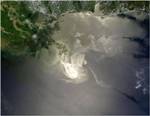|
|
 |
 |
 |
 |
|
 |
04.19.2011
A body of educational resources focused on understanding the impacts of climate change and dynamic ice cover on the eastern Bering Sea ecosystem.
MORE >>
|
|
|
03.07.2011
This resource contains links to hands-on activities, lesson plans, and background information on scientific resources for middle and high school educators, plus information on Florida Science Standards and Principles of Ocean Literacy.
MORE >>
|
 |
03.05.2011
The presentation was given by Dr. Karen Stephenson as the keynote in the session Using Network Science for Better Collaboration, held during the ASLO February 2011 meeting
MORE >>
|
 |
02.28.2011
Three compelling short videos showcase the dramatic changes in Alaska's marine ecosystems through interviews with scientists and Alaska Natives.
This video was produced by COSEE Alaska, the Alaska Sea Grant program, the Alaska Marine Conservation Council, and the Alaska Ocean Observing System
MORE >>
|
 |
02.24.2011
COSEE OCEAN co-PI Dr. Stephan Uozzo of the New York Hall of Science gave this presentation to the COSEE OCEAN Team, as an introduction to network science.
MORE >>
|
 |
02.23.2011
The results of an international expert meeting convened by UNESCO in Monaco in March, 2009.
MORE >>
|
 |
02.15.2011
Hydrothermal vents are one of the most spectacular features on the seafloor. They form in places where there is volcanic activity, such as along the Mid-Ocean Ridge. Water seeps through cracks in the seafloor and is heated by molten rock deep below the ocean crust to as high as 400°C. The hot fluid rises to the surface and gushes out of the vent openings. This hydrothermal fluid carries with it dissolved metals and other chemicals from deep beneath the ocean floor. Ecosystems have been found thriving at these vents, relying on chemosynthesis rather than photosynthesis.
MORE >>
|
 |
02.15.2011
Teaching resources about the American Lobster including alignment with learning standards.
MORE >>
|
 |
02.03.2011
Presentation given by Deidre Sullivan, Director of Marine Advanced Technology Education (MATE) Center, at the 2010 SACNAS Conference in Anaheim, CA.
MORE >>
|
 |
01.07.2011
Academic scientists have a number of avenues through which they can participate in education and outreach (E/O) programs to address the mandate for broader impacts. During this presentation, the authors presented one scientist’s perspective on the advantages and limitations of different modes of E/O and included specific examples from the past three years of working with COSEE-Ocean Systems.
MORE >>
|
 |
01.07.2011
In many educator professional development workshops, scientists present content in a slideshow-type format and field questions afterwards. Drawbacks of this approach include: inability to begin the lecture with content that is responsive to audience needs; lack of flexible access to specific material within the linear presentation; and “Q&A” sessions are not easily scalable to broader audiences. Often this type of traditional interaction provides little direct benefit to the scientists.
The Centers for Ocean Sciences Education Excellence - Ocean Systems (COSEE-OS) applies the technique of concept mapping with demonstrated effectiveness in helping scientists and educators “get on the same page” (deCharon et al., 2009). A key aspect is scientist professional development geared towards improving face-to-face and online communication with non-scientists. COSEE-OS promotes scientist-educator collaboration, tests the application of scientist-educator maps in new contexts through webinars, and is piloting the expansion of maps as long-lived resources for the broader community.
MORE >>
|
 |
12.01.2010
Comparison of results from surveying Alaska SeaLife Center staff, residents of Seward, Alaska; and visitors to the Alaska SeaLife Center.
MORE >>
|
 |
 12.01.2010
12.01.2010
Web Resources and Activities for Oil Spills and The DeepWater Horizon Oil Spill
MORE >>
|
 |
11.12.2010
Resources on oil movement and properties compiled by teachers at the 2010 MBARI/CMOP EARTH Workshop.
MORE >>
|
 |
11.12.2010
Resources on oil-eating microbes compiled by teachers at the 2010 MBARI/CMOP EARTH Workshop.
MORE >>
|
 |
11.12.2010
A presentation and lesson plan on the Gulf of Mexico oil spill compiled by teachers at the 2010 MBARI/CMOP EARTH Workshop.
MORE >>
|
 |
09.10.2010
A number of resources on the Deepwater Horizon and Exxon Valdez oil spills.
MORE >>
|
 |
08.02.2010
Discover a powerful visual tool to help your students and audiences– no matter where they live - improve their understanding of ocean and climate interactions. COSEE-OS has developed a suite of interactive multimedia tools that illustrate clear connections among and within the ocean, earth, and solar systems.
MORE >>
|
 |
08.01.2010
NASA video featuring "fly-overs" of Earth, focusing on ice.
MORE >>
|
 |
08.01.2010
Curriculum framework and Inquiry-based lesson plans about the Arctic climate.
MORE >>
|
 |
08.01.2010
Resources about the cryosphere.
MORE >>
|
 |
08.01.2010
Brief but eloquent presentation about the importance of ice and the animals that depend on ice habitat to Alaska Native culture and subsistence hunters.
MORE >>
|
 |
08.01.2010
Part 2 of a series that follows Native Thoughts on Climate Change.
MORE >>
|
 |
08.01.2010
Tracking wildlife by satellite.
MORE >>
|
 |
08.01.2010
Special collection of multimedia resources developed by WGBH Boston featuring Alaska Native knowledge, concerns, and the response of Alaska Native communities and cultures to climate change.
MORE >>
|
 |
|
 |
 |
 |
 |
|
 |
|

